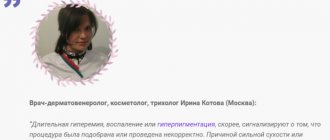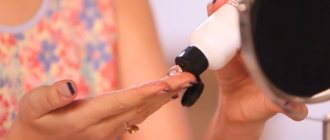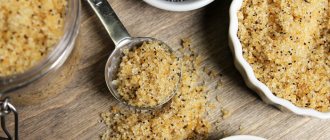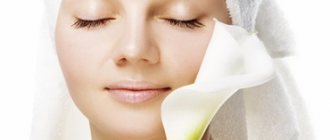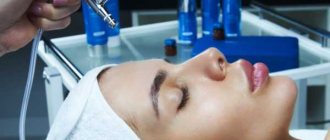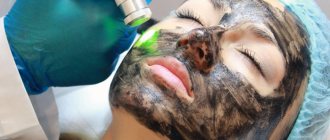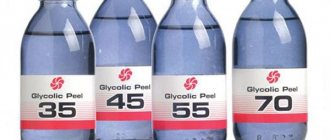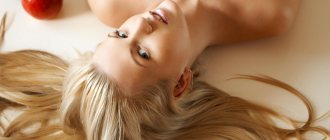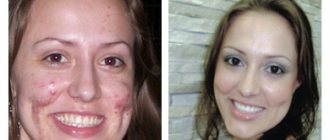From this article you will learn:
- Why is lactic acid used for peeling?
- Types of milk peelings
- Who is suitable for milk peeling?
- Contraindications to the procedure
- How does lactic acid affect the skin?
- Pros of the procedure
- Disadvantages of milk peeling
- How does the procedure work?
- Is it possible to do milk peeling yourself?
- Homemade peeling recipes with lactic acid
- Professional compositions for milk peeling
- Where is the best place to do milk peeling?
Milk peeling is one of the gentle methods of exfoliation. This service is popular because it is quite universal. Peeling can be done at any time of the year and is suitable for all skin types.
The procedure does not involve serious restrictions, including age restrictions. Exfoliation with lactic acid allows you to refresh your complexion, even out your tone, get rid of acne, dryness and flaking. We can talk about the advantages of such peeling for a long time, but it has disadvantages and contraindications. We invite you to learn more about the intricacies and nuances of the procedure.
Milk peeling (what is it)
In the reviews, many women who have tried this procedure note that with the help of milk facial peeling you can achieve amazing results. But for this you need to follow the entire sequence of actions and treat your skin with care after the session. What is milk peeling for the face?
This is the name given to the procedure, which is aimed at removing the upper, keratinized layer of skin cells.
In general, peelings can be mechanical (when the layer is actually “scraped off”), chemical (essentially a controlled burn), or physical (cells are removed with a laser or other device). Milk peeling is a variant of chemical peeling.
Before using products with lactic acid, you need to consult a cosmetologist to understand what effect to expect from the procedure.
For young girls or women of advanced age, procedures with different effects are required.
After removing the top layer, the skin is renewed, small wrinkles are smoothed out, acne does not form for a long time, and pigmentation is evened out.
Properties of lactic acid
Cosmetics manufacturers often use lactic acid (lactate) in cosmetics. It has a keratolytic effect (exfoliation), moisturizes and improves skin tone, has a sebum-regulating, bactericidal and anti-inflammatory effect.
Lactate is formed as a result of the breakdown of glucose and belongs to the category of α-hydroxy acids. When the substance gets on the surface of the skin, the process of exfoliation of its top layer starts. Thanks to this, it becomes soft and tender. After penetrating into the mouths of the sebaceous glands, lactate dissolves accumulated dirt, epithelium and cosmetic residues. This allows you to eliminate blackheads and avoid the development of inflammation. Lactic acid also contains lactathione, a natural antiseptic that slows down the proliferation of pathogenic microorganisms.
Lactic acid penetrates deeply into cell membranes and promotes the uniform distribution of active substances that nourish the skin from the inside. It is sometimes added to homemade nourishing masks for the face and body. But here it is important to maintain the correct concentration. The acid content in the mask should be minimal. But for peeling, a highly concentrated composition is used. It is absolutely safe for the skin.
Among the beneficial properties of lactic acid are:
- Stimulating active renewal of dermal cells;
- Acceleration of collagenase processes (formation of new collagen fibers);
- Improving blood circulation in the area of cosmetic procedures;
- Whitening areas of pigmentation;
- Moisturizing the upper layers of the skin;
- Activation of the epidermis’s own protective properties.
Indications and contraindications
The choice of any cosmetic procedure should be approached from the point of view of feasibility and the ratio of potential harm and benefit.
If you look at the photo before and after using lactic acid peeling, you will better see the problems that the product fights. Let's take a closer look at them.
INDICATIONS
- The presence of small wrinkles;
- Dry, tired skin;
- Acne and its consequences;
- The presence of unevenness, small scars and fresh stretch marks;
- Enlarged pores;
- Freckles and age spots;
- The complexion that needs to be “whitened.”
In addition, peeling with lactic acid at home or in a beauty salon can become a preparatory procedure for other more complex manipulations.
This procedure will help eliminate pigmentation, acne, and improve the treatment of rosacea.
MD Arnold Oppenheim
Although the procedure is quite safe, it still has contraindications.
CONTRAINDICATIONS
- Fresh cuts and wounds;
- Recent hair removal procedure;
- Oncological diseases;
- The presence of an inflammatory process;
- Herpes;
- Pregnancy and breastfeeding;
- Recent tan;
- Diabetes.
- Intolerance to the components of the drug.
Before buying facial peeling with lactic acid for home use, you should consult with a cosmetologist who deals with this procedure.
He will suggest a safe and effective remedy, and also advise on the possibility of use in a particular case.
Types of acid peels
There are 3 types of chemical peeling based on the depth of cleaning:
- Surface. It affects only the upper stratum corneum of the epidermis.
- Average. Affects the middle layers of the epidermis.
- Deep. Affects all layers of the epidermis, including the papillary layer.
Superficial peeling is considered the most popular, since complications rarely arise after it and there is no need to sit at home for 7-14 days waiting for redness, swelling or severe peeling to go away.
The main types of acid peeling include:
- Glycolic. Effective for problematic and aging skin. Glycolic acid acts on the upper layer of the dermis, burning old cells and, in contact with new ones, speeds up the metabolic process. Glycolic peeling is used for hyperkeratosis, acne, seborrhea, age-related skin changes, and age spots. The recommended course is 4-6 procedures.
- Salicylic. It has proven itself in the fight against acne, enlarged pores and oily skin. This peeling is carried out for folliculitis, hyperkeratosis, photoaging and oily seborrhea. The recommended course is 4-6 procedures with an interval of 7-10 days.
- Lactic. Suitable for sensitive and thin skin. Light superficial peeling that helps cope with acne, age spots, seborrhea, hyperkeratosis, enlarged pores, sagging skin and fine wrinkles. It has a strong moisturizing effect
- Almond. Suitable for problematic and oily skin. Used to eliminate post-acne, scars and age spots. After the procedure, the skin becomes more hydrated, the complexion is evened out, and skin regeneration occurs.
- Trichloroacetic. TCA peeling effectively combats flat birthmarks, skin unevenness, fine wrinkles, enlarged pores, solar lentigo, signs of photoaging and hyperkeratosis.
- Fruit. During the procedure, citric and malic acids are used. They cleanse the skin of dead cells, leaving it fresh and radiant. Fruit peeling stimulates cell self-healing, as a result of which they intensively produce elastin and collagen.
When choosing a peel, the cosmetologist takes into account the patient’s age, skin condition and problems that need to be worked on.
How the procedure is carried out in the salon (7 stages)
The process of removing dead skin using lactic acid is carried out in several stages:
- Makeup is removed and the skin is cleansed with lotion.
- The skin is disinfected.
- The composition itself is applied to exfoliate epidermal cells. Then you should wait from 5 to 20 minutes.
- A neutralizing composition is applied to the product.
- The resulting mixture is washed off with cool water.
- After drying the skin, moisturizing masks and creams are applied.
- The procedure can be repeated after 2 weeks.
The total number of sessions is usually from four to eight, but other options are possible.
They are best carried out during the cold season. Excessive sun activity can have a negative effect on the skin and cause pigmentation.
If you are prone to herpes, then a week before peeling you need to take antiviral drugs; this nuance should be discussed with your doctor in advance.
Stages of the recovery period
Post-peeling skin care begins immediately after the procedure. It lasts for 7 days: sunscreen with a protection factor of at least 30 SPF, moisturizing and nourishing cream are applied daily. During this period, the following rules must be observed:
- It is forbidden to comb the skin to which lactic acid has been applied;
- try not to touch the vulnerable area;
- Do not use detergents or cosmetics within 24 hours after the end of the procedure;
- Chemical and physical hair removal is not performed on the treated area;
- You will need to avoid exposure to direct UV and sunlight on the skin.
The results obtained are maintained for a year. For any serious complications, it is recommended to consult a dermatologist to reduce the risk of severe damage to the skin.
What to do after the update session (4 rules)?
After the session, the skin requires special protection and careful handling during the recovery period:
- You should not scratch your skin for several days after the cleansing session;
- decorative cosmetics should be used no earlier than after a few days;
- It is better not to use strong cleansers for 4-5 days;
- You should not sunbathe, and when going outside, even in winter, you need to use sunscreen for a week after the session.
After the procedure itself, slight redness will be observed. It may not disappear for a couple of days.
In the future, you should be prepared for peeling, which lasts about a week. Please be patient until the formed crust comes off on its own. Don't touch her again! Don't rip it off!
Peeling indicates that cell renewal processes have started.
Plastic surgeon Asif Pirani
After peeling, you should expect not only peeling, but also a burning sensation.
It would be better if the woman did not apply cosmetics to her skin during the recovery period.
Recommendations to follow after peeling
Main recommendations.
- Do not touch the skin and do not scratch under any circumstances.
- Give up decorative cosmetics for a day.
- Avoid harsh cleansers for a day.
- Removing hair from treated areas is prohibited.
- The skin should be protected from exposure to direct rays of the sun.
Recommendations must be followed
What result should you expect?
If the procedure promises a stunning result, then, probably, many women are ready to endure both peeling and crusting. But do the price, side effects, and milk peeling justify it?
In this case, most cosmetologists will recommend this procedure. Since just a couple of sessions lead to such changes:
- wrinkles are reduced;
- skin tone improves;
- freckles and pigmentation lighten;
- Acne marks become less noticeable, sebum production decreases;
- dryness disappears, the skin stops itching.
The condition of the skin improves significantly after peeling. The problem of oily shine on the face disappears.
Plastic surgeon Brian Harmych
The essence of technology
The principle of action of acid peeling is to provoke a chemical burn of the skin, in response to which restoration processes are launched in the skin. The procedure helps achieve skin rejuvenation and eliminate a number of problems. After peeling, active cell division occurs in the skin, renewal of the epidermis is accelerated, which leads to an improvement in the appearance of the skin. In addition, acids cleanse the ducts of the sebaceous glands, reduce excess oil, stimulate skin fibroblasts, which leads to increased collagen synthesis.
Question answer
This problem is best dealt with by TCA peeling.
In addition, it is recommended to pay attention to laser resurfacing or other hardware techniques. With such skin, you risk encountering age spots. It is better to contact a cosmetologist who will select a more suitable option, taking into account the phototype.
To begin with, you should wait for the complete restoration of the skin and the completion of the rehabilitation period. Only then can you go for contour plastic surgery.
How to exfoliate yourself
At home, it is quite possible to conduct a session of removing dead particles of the epidermis. You can make your own milk peeling composition using proven recipes, or you can resort to industrial compositions.
When purchasing a product, carefully read the instructions for use and the composition of the product: not all components are suitable for every type of epidermis.
Regardless of whether you chose milk peeling spa technology from Tian De , or Aravia professional peeling with lactic acid lactica exfoliate , or any other product, you should take care of thoroughly cleansing the skin, applying a high-quality neutralizing composition, and a moisturizing mask.
It is most convenient to use drugs from the same manufacturers as the main product.
If you are not sure of the correctness of actions, then first you can try a more delicate product, for example, peeling Milk Mousse PREMIUM Professional from a Russian manufacturer with lactic acid.
It acts more gently than conventional products, the effect is less noticeable, but you don’t have to worry about unwanted consequences if used incorrectly.
Before the procedure, be sure to cleanse your face first with lotion and then with alcohol or an alcohol-containing liquid.
The composition itself is applied first to the forehead, then to the temples, chin, the rest of the face, and neck. It is convenient to distribute the mixture with either a cotton pad or a makeup brush.
Then you should wait the time specified in the instructions. For example, the manufacturer recommends applying Aravia peeling with lactic acid for 2 – 10 minutes.
A slight burning sensation during the procedure is normal, but if it becomes unbearable, the session must be stopped immediately to avoid burns.
Despite the fact that some manufacturers write “professional use” on the packaging (as, for example, it is indicated on the packaging of the peeling product with 10% lactic acid lactica exfoliate from Arabia), it is suitable for home use, although it requires more care when working.
TYPES OF HOME REMEDIES AND HOW TO PREPARATE
Lactic acid, among other things, is also very cheap: 100 ml of the product can be bought at a pharmacy for only 50 rubles (approx. 0.7 euros). This volume is enough for a whole year of regular use on almost the entire body.
The drug is also sold in soap factories and pet stores. Sometimes it is replaced with “Hilak Forte” drops, which are 90% MK.
How to dilute lactic acid with water (Table)
| % ACID IN THE FINISHED PRODUCT | PROPORTIONS (ACID:WATER) |
| 30% | 1:1,5 |
| 10% | 1:7 |
| 5% | 1:15 |
| 3% | 1:25,5 |
| 1% | 1:79 |
| 0,5% | 1:159 |
To prepare home remedies based on LA, you can use a miniature measuring container (for example, a pharmaceutical syringe) and measure out the required number of parts of water and acid according to the proportions. Prepared solutions can be placed in clean medicine bottles with stickers indicating the % content of the reagent.
Before using any products, you need an allergy test on the forearm, and you can directly draw circles on your hand with a ballpoint pen and sign them with the corresponding percentages of acid, and then see how the skin behaves in this place for 24 hours after applying the samples. You should start with the weakest solutions and gradually move to stronger ones.
What drugs can be created based on MK:
- Tonic (0.5%): suitable for daily wiping the face after morning and evening washing. After the first use, the skin acquires a healthy glow. Also suitable for body skin care after sugar depilation (sugaring).
- Cream (0.5 ml of 80% MK, or 1/10 tsp, add to the finished baby cream): good for treating rough elbows and corns.
- Masks (diluted with a small amount of tonic 0.5%): dry without tightening the skin while maintaining the effect + acquire new functions (whitening, exfoliation, etc.).
- Peeling socks (80% MK solution). Some girls use acid on their heels even without washing off, but don’t forget about the allergy test!
We recommend: CONTRAINDICATIONS TO PEELING: you cannot exfoliate, wait!
Homemade recipes for peeling compositions
If you want to experiment and feel like a real chemist, you can prepare a composition for peeling with lactic acid yourself.
Even if you are completely confident in the correctness of the prepared composition, be sure to test it on the skin of your hand, for example, in the wrist area.
The pharmacy chain sells formulations containing 80% lactic acid. This concentration is unacceptable for use at home.
To prepare the peeling mixture, you need to add water. Depending on the sensitivity of the facial skin, a 10-20% solution is used.
It is convenient to use a syringe for preparation. 1 ml. acid and 7 ml. water will give a 10% solution, to obtain 20% - 2 ml of acid and 6 ml. water.
Mix the resulting composition thoroughly. If you use it only for the face, it will be enough for about two procedures.
Apply the resulting solution to thoroughly degreased skin. For the first procedure, limit the time to one minute or less. You can wash off the homemade peeling with ordinary cool water.
Slight redness and burning are a normal skin reaction. After the procedure, you can apply a moisturizing, soothing cream, or make a mask with aloe. In the future, the duration can be increased.
If there are children in the house, make sure that neither the prepared composition nor the concentrated acid becomes the subject of children's games.
Chemical burns, although they can be treated, the degree of cure depends on many parameters and is not always 100%.
To rejuvenate the skin of the heels, acid with a concentration of 25-60% is used. If the skin is very rough, a more concentrated solution can be used.
For the first time, you should start with a 20% solution. In subsequent procedures, the feet can be wrapped in polyethylene after applying the acid. After rinsing, be sure to use a rich cream.
Products with BHA acids for peeling acne-prone skin
What these acids do: BHAs dissolve in fat. Thanks to this property, they penetrate the skin a little deeper and cleanse the pores of accumulated sebum. AHA acids can't do that. Therefore, this type of acid is used in the treatment of acne. There is also evidence that BHAs can protect the skin from the sun. But since SPF is not indicated on peelings in the store, it is better to use sun protection. Just in case.
Representatives: most often - salicylic acid and its derivatives, less often - beta-hydroxybutyric and tropic acids.
- Peeling Shine Is Lightening Control, 629 rubles - several types of acids are mixed inside. A little salicylic acid was added to the AHA acids - lactic and glycolic. The product also contains vitamin C. Peeling solves several problems at once: removes pigmentation, makes the face radiant, and also fights inflammation. It is recommended to keep the product on the face for 3 minutes at first, and eventually reach 10 if the skin gets used to it.
- Exfoliating lotion DTM Skin, 1,690 rubles - lotion from the brand Adele Miftakhova. Inside is salicylic acid, flavored with niacinamide and azelaic acid. The product reliably gets rid of open and closed comedones, reduces skin oiliness and evens out tone.
- Facial peeling based on BHA acids Seveki, 339 rubles - a budget product with a good composition. The percentage of acids in your jar can be adjusted. Beginners will be introduced to a product with a lower acid content. Grooming connoisseurs can switch straight to full strength 2% salicylic acid. Each product is provided with detailed instructions on how to use the serum, how often and what can be added to it.
- Biorace red exfoliating serum with AHA and BHA acids, 1,880 rubles - the product is similar to the bloody peeling from The Ordinary brand. And in general it does the same thing to the skin. It’s just easier to find, buy and deliver it home. The red color is just a decorative element; in fact, the product is not dangerous for the skin. The composition contains alkalis - they neutralize acids and prevent them from harming the skin. Use no longer than 5 minutes and no more than 2 times a week.
TOP 5 best products for milk peeling
There is more than one option for milk peeling, but some are still more popular. Below is the TOP 5:
- Milk peeling Compliment has quite contradictory reviews from users. On the one hand, it is quite effective for dry skin, but on the other hand, it can cause severe irritation.
- Facial peeling with lactic acid Aravia (Arabia) from a Russian manufacturer - has collected a lot of positive user reviews. Quite an effective product, especially for oily skin. Use with caution at a young age.
- Milk peeling Tian De (tiande) spa technology , according to reviews from women who have used it, is a relatively budget option that can be bought for home use. Quite gently exfoliates dead skin; in addition to the face, it is used to renew the skin of the hands, elbows, and décolleté. But the parabens included in its composition cause concern among some buyers.
- Belarusian peeling from the manufacturer Belita-Vitex PROFESSIONAL FACE CARE. Also a budget option for home use. It is not as active as its Western counterparts, but it is effective. The disadvantages of this product include a rather strong smell.
- Sesderma facial peeling from a Spanish manufacturer is not so actively used by Russian consumers, but it deserves attention. Well suited for young skin whose main problem is rashes.
This list is not exhaustive. In addition, you should always remember about individual intolerance, so before the first use you need to test the composition on a small area of skin on your hand.
Lactic acid perfectly moisturizes the skin.
Plastic surgeon Brian Harmych
Moisturizers with SPF that you will need when using acids
- Avene Hydrance Cream, 1,274 rubles - a pharmacy moisturizing cream also protects from the sun thanks to SPF 30. Nourishes dry skin and prevents age spots and wrinkles.
- Lebelage sunscreen moisturizer with aloe extract, 522 rubles - Korean sunscreens protect against two types of sun rays at once to prevent both skin cancer and premature aging. Judging by the reviews, it does not clog pores and does not provoke inflammation. On the contrary, it moisturizes the skin and soothes it.
